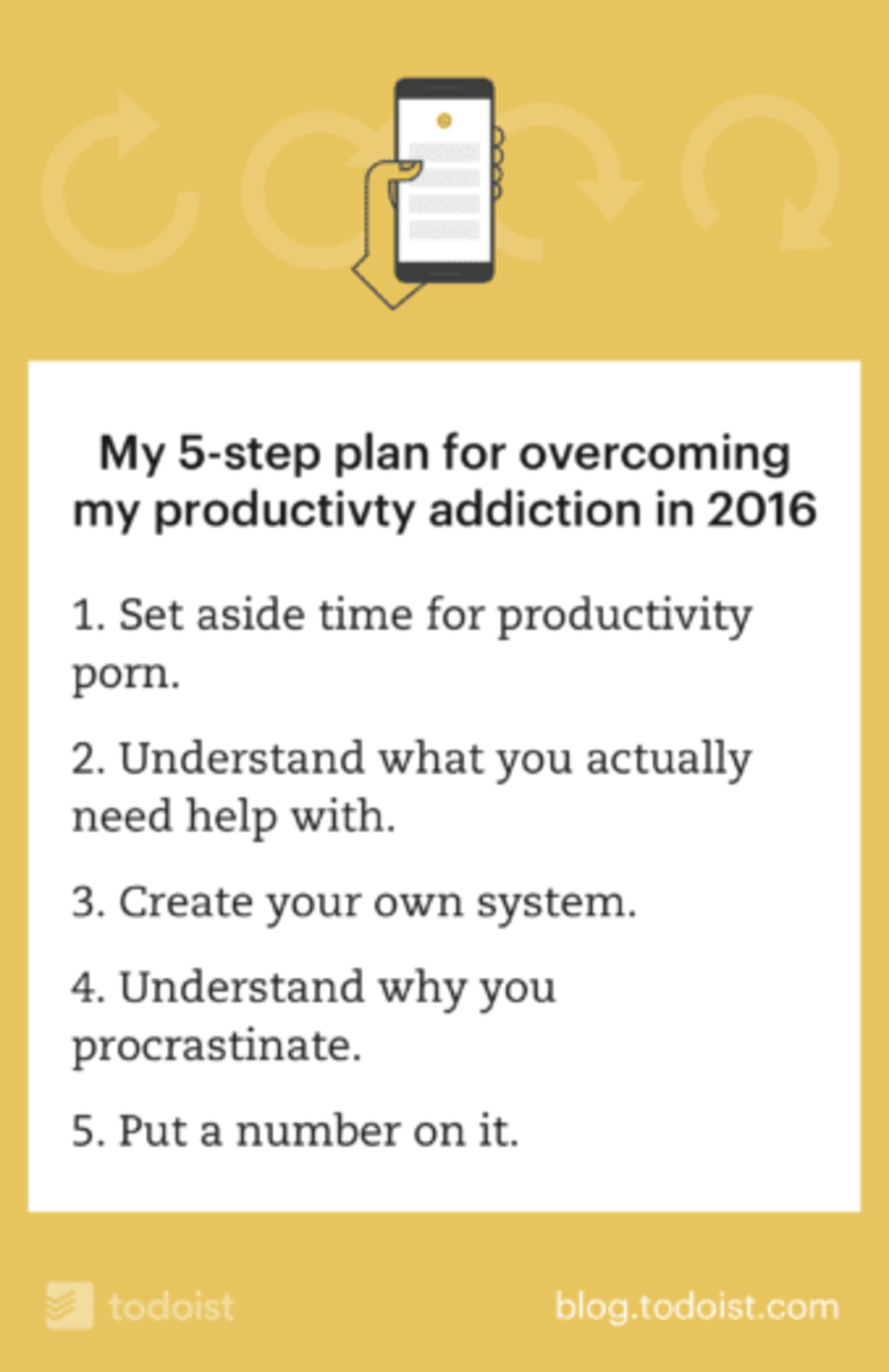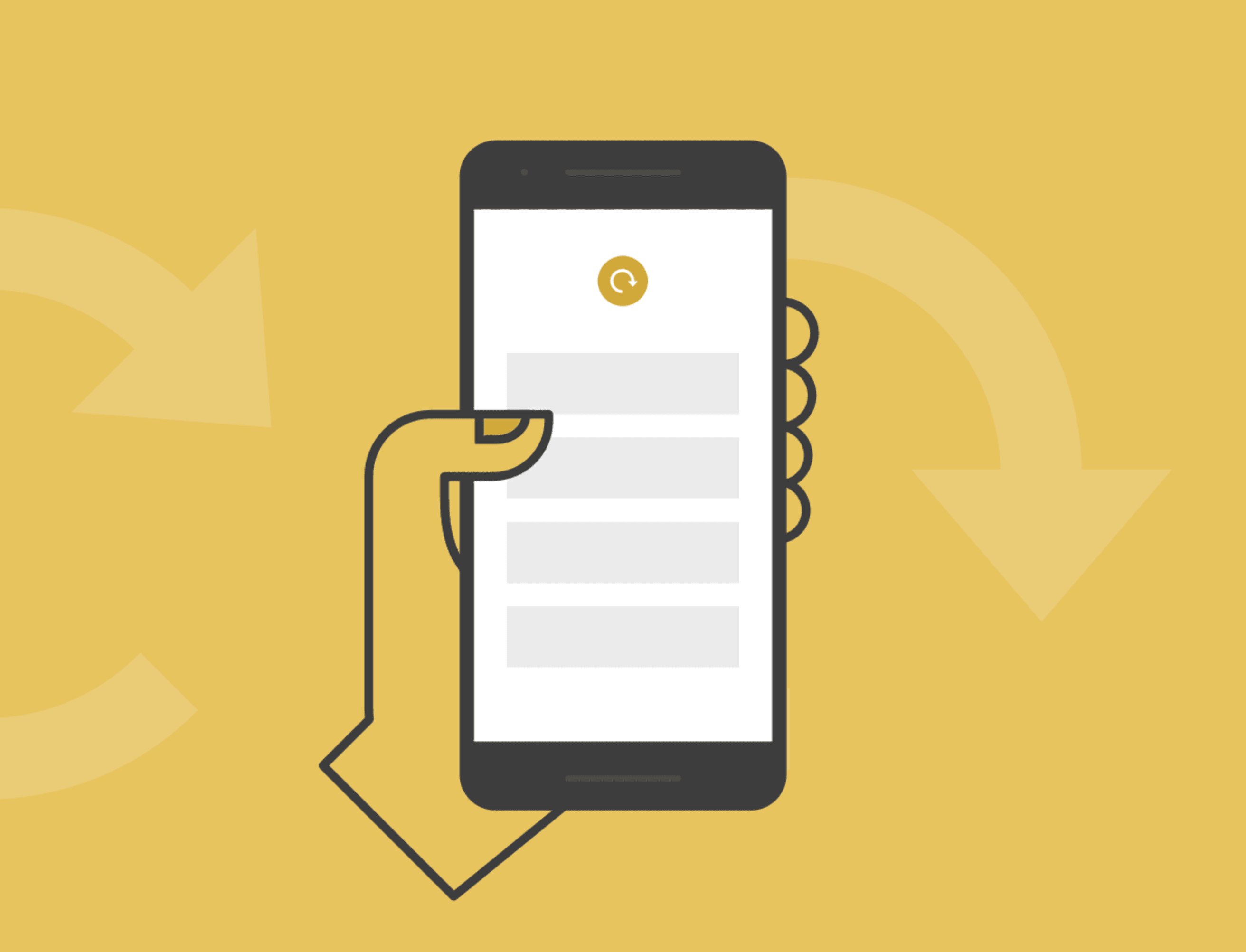Hi, my name is Belle and I’m addicted to productivity.
I don’t mean the real kind of productivity where I actually move my important projects forward. No, I’m talking about productivity content - the countless articles, videos, infographics, e-books, real books, whitepapers, and email courses out there that I can’t seem to get enough of.
I spend a lot of time trying new productivity tools and reading about productivity methods. I’m not sure how this all started, but it’s crept up on me over the years. These days I can’t go a week without spending a few hours trying new apps - or even adjusting my whole workflow - just to try something new. While experimenting with my workflow can be helpful (sometimes), it also eats up a lot of my time without actually moving my real work forward.
And it seems I’m not the only one.
The problem with this idea of “productivity porn” taking up all our time is that nobody seems to have a solution for how to avoid it. If you enjoy watching videos and reading articles about productivity methods, trying new tools, and planning how to get more work done, you’re probably in the same situation I am. You want to accomplish more, but you inevitably procrastinate on the actual work in favor of looking for new hacks, systems, and apps to solve all your problems.
As James Bedell has noticed, productivity porn isn’t the answer to actually being more productive:
The most productive people I know don’t read these books, they don’t watch these videos, they don’t try a new app every month. They are far too busy getting things done to read Getting Things Done.
In 2016, I resolved to overcome this addiction, but in classic New-Year’s-resolution fashion I didn’t get far.
Ironically, when searching for ways to avoid productivity porn, I ended up reading more of the stuff. Nobody seems to offer more than a warning against wasting time thinking about productivity instead of working. But I wanted real, solid techniques I could use to stop this bad habit from taking over my work days.
Here is the 5-step approach I came up with to make sure I get more real work done this year...

1. Set aside time for productivity porn
I like learning about productivity. I like hearing about the systems, hacks, and tools that other people use to get things done. So my first step was to recognize that I enjoy this, and that’s ok. I needed to figure out how to keep doing it without hurting my workload.
I started by setting aside time specifically for productivity content. That’s all the videos, photos, and articles that I enjoy consuming, but which don’t directly help me get more work done. The ones I read just for enjoyment. I don’t want to deprive myself of that, but I need to stop letting it derail my working hours.
So I set aside a chunk of time when it’s okay to browse productivity blogs and fall into YouTube holes of video after increasingly irrelevant video. Personally, I like to start my mornings with some writing, so I let myself take a break for reading productivity content after my morning writing session is done. This way I’ve at least done some useful work before I let myself get drawn in.
Scheduling in this time also makes it easier to put off the productivity black hole in the mornings, because I know it will only be a couple of hours until I get to indulge guilt free.
2. Understand what you actually need help with
One of the problems with productivity resources is that I tend to get sucked into all of it. It’s too easy to read everything I come across just in case I find something useful.
This year, I’m trying to be more mindful about what I read, watch, and listen to. Rather than taking in everything, I’m attempting to think carefully about what specifically I need help with.
For instance, if you’re new to remote working and want to get better at team communication and collaborative work, you could focus on just the productivity-related learning that pertains to those topics. If you’re struggling to get on top of your schedule, you might focus on blogs and podcasts that talk about scheduling, calendars, and planning your time more effectively.
For me, I’ve been working on combining my Todoist planning with an analogue system, so I’m trying to focus on learning about ways to plan on paper more effectively.
Of course, only saying yes to some productivity resources means saying no to others. But the great thing about productivity is that there are always more resources coming at you. So when you decide to focus on a different aspect of your workflow later, no doubt you’ll find plenty of resources available.
3. Create your own system
When I was researching this post, a comment I saw often about productivity content was that it stems from learning and implementing other people’s systems. For example, reading David Allen’s book and changing your entire workflow to use a GTD set-up. Or discovering the Bullet Journal system and reorganizing your entire life to be run from a notebook.
While this can be fun (trust me, I love doing this as much as you do), it’s also a huge time waster. And it’s rare that you’ll find someone else’s system perfectly suits your needs. Even adamant GTDers adjust the system to suit their particular workflow. Some barely use particular features of GTD, while others bend some features to match their needs.
What I’ve found works best for me is to strip away any ideas about systems and tools, and to start by thinking about what I need. When I realize I’m spending too much time trying various tools or methods (that’s right, I’ve done this before and then fallen into the productivity trap all over again), I strip away everything but pen and paper. Then I think about my responsibilities, how I like to work, and plan out what the perfect system for me would look like.
Once I know my exact needs, I can find the right systems or tools to suit me, rather than trying to fit into the way other people work. This year, my pen and paper exercise helped me figure out that Todoist was the only tool that suited my exact needs for digital task management (convenient, since I’m writing on the Todoist blog, but also completely true). It also helped me see that an analogue component would help me with the things I didn’t like doing digitally.
Since everyone has their own particular quirks and methods, you’re unlikely to find something online to perfectly suit you. But if you figure out what you need first, you can more easily recognize the approaches or apps that will actually help rather than distract you.
4. Understand why you procrastinate
I use productivity porn as a fun way to procrastinate. If you do too, understanding why you procrastinate can help you get to the root of the problem and fix it.
Procrastination is actually something we do to avoid negative emotions. By spending time on productivity research, checking Twitter, or watching Netflix, we’re aiming to repair our mood by doing something that makes us feel better than the work we should be doing. We procrastinate to avoid boredom, frustration, stress, loneliness—a whole host of negative emotions.
Productivity porn is an especially insidious form of procrastination because it feels like you’re doing something productive, but that lost time comes at a cost. Procrastinators are more likely to be unemployed and have lower salaries, according to a study of over 22,000 people. Despite the negative results, around 20% of adults and up to 70% of college students claim to be chronic procrastinators.
That’s kind of depressing, right? But knowing where procrastination comes from can help us to avoid these negative side effects. For instance, structured procrastination, or “productive procrastination” can help you put this so-called bad habit to good use. Investor and entrepreneur Paul Graham has an interesting way of thinking about procrastination that illustrates how it can be used as a good thing. Depending on what you do instead of the work you should be doing, your procrastination can fall into one of three categories, according to Graham:
- You do nothing
- You do something less important
- You do something more important
It’s probably obvious already, but if you choose to do something more important than the work you’re putting off, you’re actually procrastinating in a productive way. For instance, you can put off an email you don’t want to deal with or a phone call you don’t want to make, in order to work on pitching new clients or getting started on a new project.
So the next time you find yourself getting sucked into the productivity porn vortex, identify one important, not urgent task you could be doing instead and procrastinate productively.
5. Put a number on it
If goal-setting and tracking helps you change your habits, try putting a number on your productivity addiction. Then set daily goals for the time you want to give yourself for consuming productivity content. Having a concrete goal may be the motivation you need to stop reading about productivity and actually be productive.
Start by tracking how much time you spend reading about productivity when you should be working. I’m not a fan of complicated time trackers, but there are two easy ways to get an idea of what you’re doing throughout the day.
One is to use RescueTime to automatically track which websites and programs you spend most of your time in. RescueTime has a generous free plan that runs a tracker in the background and lets you see reports for each day. You can classify websites and apps as productive or distracting, and get a quick overview of how you’ve spent your time once the day is over.
Another simple way to keep an eye on how you’re spending your time is to use this pen-and-paper tracker:

To set this up, just draw out a line of squares in your notebook or on a scrap of paper. Each square represents an hour of your workday. As each hour rolls by, write in the box how you spent your time. This idea comes from Gabi Garcia Fdez, who uses it to track how much time he spends on programming versus management tasks and meetings:
I took my trusty Moleskine notebook and I outlined a rectangle big enough to split it on 8 small squares, one for each work hour. Every hour I put a “P” (programming) or a “G” (gestión, the Spanish word for management) depending on what kind of tasks I did.
After you've established a baseline for how much time you're spending consuming productivity content, set a daily goal for yourself to work towards.
The truth about truly productive people is deceptively simple. I can’t put it any better than James Bedell does here:
What they’ve also come to accept is that working hard is indeed, just hard work. There’s no trick to it. They might take notes digitally they might write things down on paper. They might forget stuff, but they are always thinking about what they need to do next and then they start doing it.
The battle against productivity porn is an ongoing challenge. I’m optimistic that these approaches will help me keep the habit contained, if not overcome it completely. But I’d love to hear how you deal with your productivity addiction. If you have any ideas for stopping productivity porn from taking over your ability to actually be productive, let me know in the comments below.

